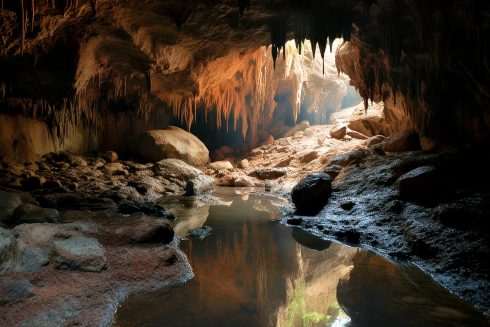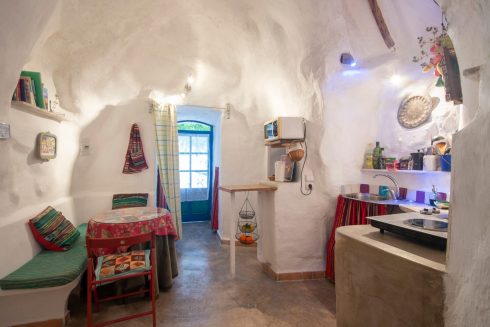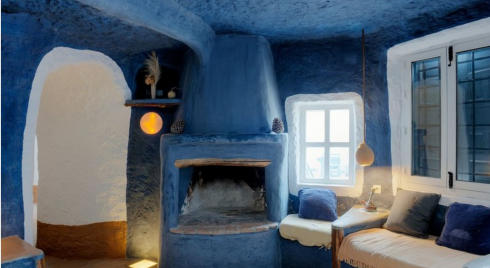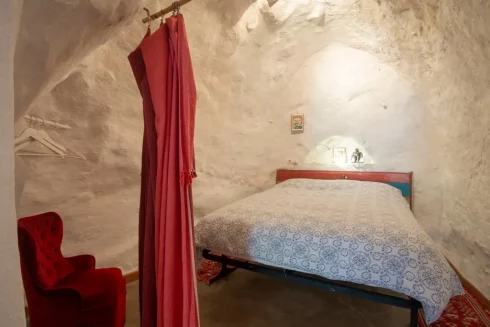EXTREME athlete, Beatriz Flamini, recently caught Spain’s attention by spending 500 days in a cave in Los Gauchos, near Motril. Her idea was to write about the troglodyte lifestyle and attempt a world record for solo cave-dwelling.
Staying 70m below earth, unable to tell day from night, Beatriz journalled about living in isolation. It wasn’t glamourous. There were no bathroom facilities and she emerged on April 14 saying that she needed a shower.
While being confined in a dark space isn’t everybody’s cup of tea, we can enjoy the benefits of caves, in smaller doses. In various parts of Andalucia, you can rent your very own cave, to test out the lifestyle.
The options range from bijoux dwellings bedecked with traditional, Moorish-style soft furnishings to fully serviced ‘demi-caves’ (partially underground), and more luxurious hosted options with swimming pools and hot tubs.
Subterranean style might be a trend this summer!

Where are the caves?
You’ll find cave houses, cave hotels, and even cave restaurants in areas such as Guadix and Sacromonte – both in the Granada region – and in parts of Almeria, including Baza.
According to National Geographic, cave dwellings were first adopted by inhabitants of southern Spain to shelter from storms and predatory animals and, later, religious and racial persecution.
The idea of ‘shelter’ still applies today, with some people living off-radar in the caves of Granada’s Sacromonte. Some people were born in the caves and have remained there all their lives, sometimes co-habiting with animals.
Traditionally, cave houses were favoured by the Gitano community. Today people of various nationalities invest in them because of the low impact on the environment and cool (literally) vibe.
Many cave-owners report a strong sense of community and heritage. Some older caves are decked out with flamenco memorabilia and are strongly linked to the history of ‘Sevillana’.

Why would I rent a cave?
While Flamini described her time underground as ‘excellent’, most of us would prefer a few mod-cons in our cave. A subterranean paradise has its own bathroom!
A big advantage of cave houses is that they maintain a temperature of about 20 degrees all year round. This means they are warm in the winter and cool in summer – when most of us are freezing or sweltering. For the coldest days, some caves are equipped with wood-burners.
With silent and dark bedrooms – traditionally without windows – caves encourage peaceful sleep. This is a compelling reason to choose a cave over a ‘hostal’ or cheap hotel.
Especially in summer months, the city streets can be noisy. Even if your hotel room has double glazing, some light and noise pollution will creep through. Silence, in your cave, is golden.

Longer stays?
The Olive Press spoke to Amelia Michaelson, a British cave-dweller of Sacromonte, Granada, who lives there permanently. She enjoys life underground.
She says: “It’s a great feeling, being inside the earth. A different kind of silence and a special, intimate space.”
“How much light you have depends on the size of the cave, where the windows and doors are positioned, and the material. The caves are all constructed with domed ceilings and archways, so they don’t collapse. They must be ventilated, like any other house.”
The cave-dwellings are handily located on the doorstep of Granada’s thriving tourist centre.
Amelia explains: “Sacromonte is based on the outskirts, a 15-minute stroll from Plaza Nueva and the cathedral. There are guided tours of the main attractions, tourists from all areas, and many hikers and cyclists. Lots of walking trails go from Sacromonte, up the valley, or across to the Alhambra area of Granada.”
One thing to bear in mind: when returning from the tourist centre, you have an uphill stroll.

The pros of cave accommodation
- Traditional cave areas, such as Sacromonte, are steeped in history and tradition.
- Being on the side of mountains, some of the cave neighbourhoods have stunning views.
- You can rent an entire home, not just a hostel room.
- Interesting décor.
- Achieve an intimate, cosy feel.
- Cool and tranquil.
- Be a hobbit!
- Resistant to earthquakes!
The cons
- Some caves don’t have mobile phone coverage inside, although rental caves will provide WiFi for tourists.
- Some cave rentals are a long walk from the nearest parking (especially in Sacromonte). This isn’t suitable for people with mobility problems.
- You might have to walk uphill after visiting tourist attractions.
- Not ideal if you’re claustrophobic.
Cave trip ideas
- Nerja caves – visit a series of caverns in the coastal town of Nerja, in Malaga region.
- The mines of Lújar near Órgiva – public visits can be arranged in groups of 3-4 and the mines will open to the public in 2025.
- Sentenil de las Bodegas, Cádiz – this town grew out of a network of caves in the cliffs above the rio Trejo north-west of Ronda. There is evidence of other nearby cave-dwelling societies, such as at Cueva de la Pileta, west of Ronda.
- Book a cave hotel with a pool – Cuevas Helena – or a hot tub at Las Dunas, Baza.
- Dine in a cave restaurant, such as El Templo del Flamenco in Granada.
READ MORE

